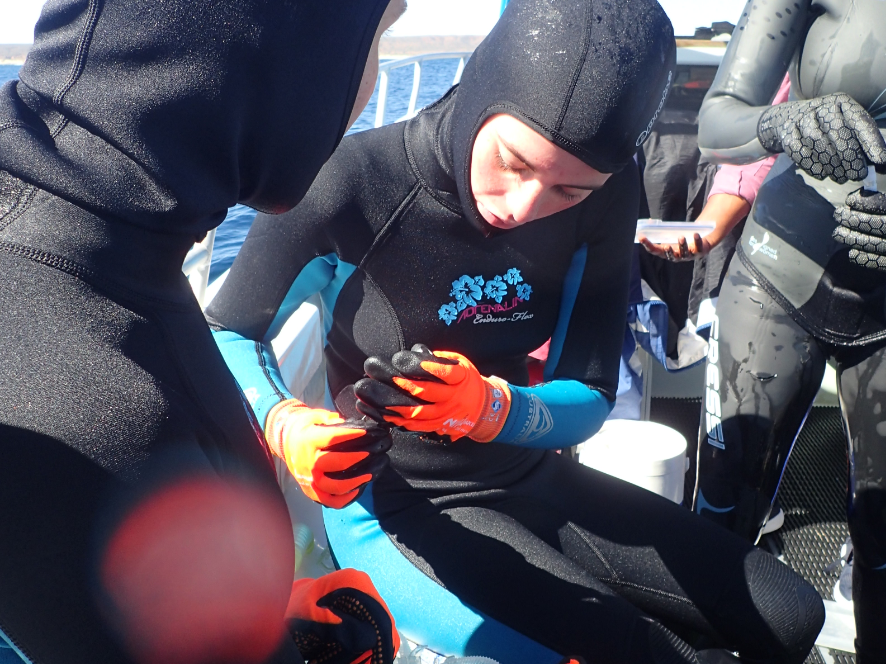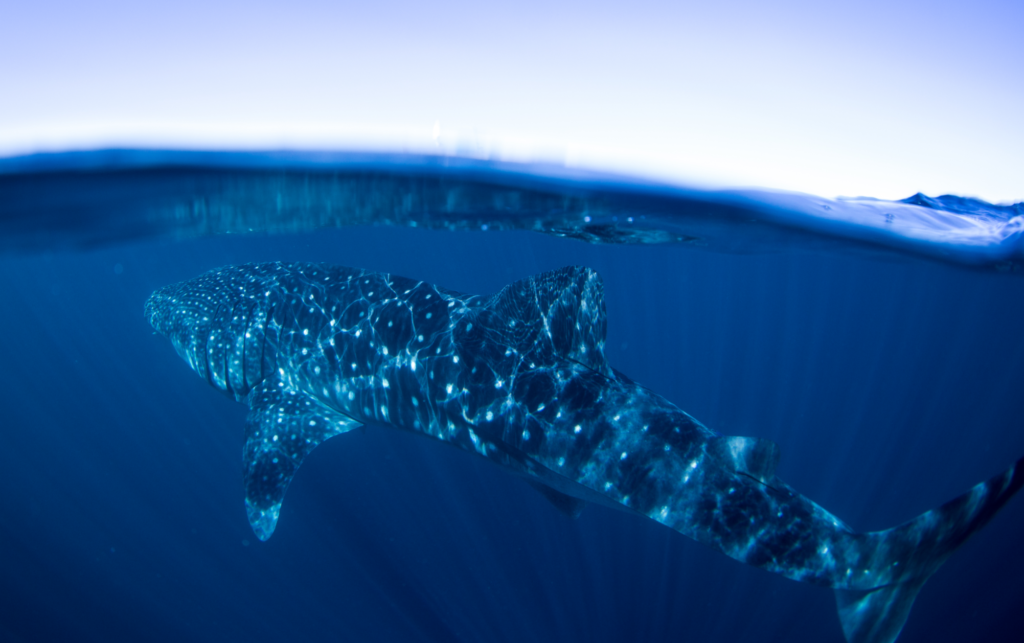
Jenna (foreground) and Cayci removing the whale shark tissue sample for storage in ethanol to preserve the DNA used by researchers.
Imagine swapping out your school uniform for a wetsuit and snorkel gear! Sound swell? Well, that’s what two year-10 students did recently when they joined our scientists on a whale shark field trip to Ningaloo Reef.
As part of our Ningaloo Outlook research program with BHP, Cayci and Jenna, students from Exmouth District High School, ditched the classroom for a much sought-after spot on a Ningaloo research trip.
They joined our team who were in the field to conduct an annual DNA sampling of whale sharks. Together we collected data on the sex and size of individual sharks and took DNA samples from 100 individual sharks. All these data are being used to estimate the age and population size of whale sharks.
On this extraordinary school excursion, Cayci and Jenna got to learn a whole lot. This included whale shark biology and ecology as well as oceanography and the Ningaloo Reef ecosystem.
They also helped our researchers out on the day. They obtained photographs of whale sharks, process DNA samples and fill out data sheets with information collected by our researchers.
Dr Rich Pillans, who leads our whale shark research for Ningaloo Outlook, said whale sharks are the biggest fish in the sea.
“They are listed as endangered by the IUCN so knowing how many animals there are is critical to understanding population decline or recovery,” he said.
“Our research at Ningaloo aims to determine the population size of whale sharks using methods developed by CSIRO.”
Feeding frenzy
As well as the 100 samples captured during the trip, the team witnessed a rare feeding frenzy. The team saw about 50 whale sharks feeding in the one place.
“We know that Ningaloo attracts an aggregation of whale sharks, but we’ve never seen this feeding behaviour before,” Rich said.
In this region, the Leeuwen Current meets the Ningaloo current creating an upwelling of food for the whale sharks. With an abundance of tasty treats, it has turned into destination dining for these aquatic giants.
The fast and the curious
Giving students firsthand experiences with marine science has been a key activity of the Ningaloo Outlook program since it began in 2015.
Swimming with the whale sharks, Cayci and Jenna learned to use stereo cameras to measure shark length.
They also ‘clasped’ what to look for to distinguish males from females. The male whale sharks have a clasper underneath their torso which the females do not have.
“Interestingly, teenage males make up most of the Ningaloo population, and we’re yet to discover where the adult females are,” Rich said.
A whale of a time
Cayci and Jenna found their day on board with the researchers “an amazing experience”. They report the experience has inspired them to think about a future in marine science.
“Having Cayci and Jenna on board for the day was the highlight of the trip for all of us,” Rich said.
“Experiencing real science at sea is a unique experience, and hopefully one that sparks a long-lasting curiosity in STEM for Cayci and Jenna. Our Ningaloo Outlook education and outreach program give us an opportunity to share our research with the Exmouth community.
“Now Jenna and Cayci are our student ambassadors, sharing first-hand stories of what they have learned and experienced with their family and friends,” he said.
While not all the students can go on field trips, there are many other learning opportunities throughout the program.
“It was fantastic to share our research with them,” Rich said.
“We love to share our science with students who live in this special place, to enhance their knowledge on their local marine ecosystems, turtles and whale sharks.”
Ningaloo Outlook is a collaboration between CSIRO and BHP to increase our understanding of Ningaloo Reef. Together we are investing $12.4 million over 10 years (2015-2025) to support research on whale sharks, turtles, shallow and deepwater habitats.

We’ve been researching whale sharks in the area as part of Ningaloo Outlook since 2015. Image credit for: Rich Pillans, CSIRO.


22nd July 2021 at 12:22 pm
Congrats Richard. Great outreach.